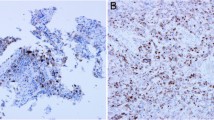Abstract
Glioblastoma multiforme (GBM), a WHO grade IV malignant glioma, is the most common and lethal primary brain tumor in adults and has but few treatments. The median survival of glioblastoma patients is 12 months. The (possible) relationship between human cytomegalovirus (HCMV) infection and cancer has been investigated for decades. Detection of viral DNA, mRNA and/or antigens in tumor tissues suggests that HCMV infection has a role to play in the etiology of several human malignancies. HCMV gene products can promote the various signaling pathways critical to tumor growth, including platelet derived growth factor receptor, phosphatidyl inositol 3-kinases (PI3K/AKT), signal transducer and activator of transcription 3 and glycogen synthase kinase 3 beta that are involved in apoptosis, angiogenesis, invasion and immune evasion. Insulin-like growth factor binding protein 2 (IGFBP2) is a biomarker of the PI3K/AKT pathway so we decided to evaluate the expression of this gene in 3 groups: HCMV-negative GBM tissues, HCMV-positive GBM tissues and non-tumor tissues. The presence of HCMV was assessed according to our previous article. HCMV was present in %75 of glioblastoma tissues. Then RNA was extracted, cDNA was synthesized, and real-time PCR was performed. Then, the rate of increased expression was calculated using the Livac or 2−ΔΔCt. ΔCt of samples in the three groups were compared using analysis of variance (ANOVA). The expression of IGFBP2 gene relative to GAPDH gene in HCMV-negative glioblastoma tissues and HCMV-positive glioblastoma tissues, respectively, was increased 5.486 and 15.032 times compared to non-neoplastic brain tissues. ANOVA tests showed that the difference of mean ΔCt for IGFBP2 gene between healthy subjects and patients with HCMV-positive and HCMV-negative glioblastoma tumors statistically significant.


Similar content being viewed by others
References
Cobbs CS, Harkins L, Samanta M, et al. Human cytomegalovirus infection and expression in human malignant glioma. Cancer Res. 2002;62:3347–50.
Cobbs CS. Evolving evidence implicates cytomegalovirus as a promoter of malignant glioma pathogenesis. Herpesviridae. 2011;2(1):10.
Yongjun Yu, Alwine JC. Human cytomegalovirus major immediate-early proteins and simian virus 40 large T antigen can inhibit apoptosis through activation of the phosphatidylinositide 3′-OH kinase pathway and the cellular kinase Akt. J Virol. 2002;76:3731–8.
Caposio P, Orloff SL, Streblow DN. The role of cytomegalovirus in angiogenesis. Virus Res. 2011;157(2):204–11.
Ranganathan P, Clark PA, Kuo JS, Salamat MS, Kalejta RF. Significant association of multiple human cytomegalovirus genomic loci with glioblastoma multiforme samples. J Virol. 2012;86(2):854–64.
Dziurzynski K, Chang SM, Heimberger AB, Kalejta RF, McGregor Dallas SR, Smit M, Soroceanu L, Cobbs CS. Consensus on the role of human cytomegalovirus in glioblastoma. Neuro Oncol. 2012;14(3):246–55.
Hollon TC, Price RL, Kwon CH, Chiocca EA. Mutations in glioblastoma oncosuppressive pathways pave the way for oncomodulatory activity of cytomegalovirus. Oncoimmunology. 2013;2(9):e25620.
Barami K. Oncomodulatory mechanisms of human cytomegalovirus in gliomas. J Clin Neurosci. 2010;17:819–23.
Fuller G, Rhee C, Hess K, Caskey L, Wang R, Bruner J, Yung A, Zhang W. Reactivation of insulin-like growth factor binding protein 2 expression in glioblastoma multiforme: a revelation by parallel gene expression profiling. Cancer Res. 1999;59(12):4228–32.
Wang H, Wang H, Shen W, Huang H, Hu L, Ramdas L, Zhou YH, et al. Insulin-like growth factor binding protein 2 enhances glioblastoma invasion by activating invasion-enhancing genes. Cancer Res. 2003;63(15):4315–21.
Santosh N, Arivazhagan A, Sreekanthreddy P. Grade-specific expression of insulin-like growth factor- binding proteins-2, -3, and -5 in astrocytomas: IGFBP-3 emerges as a strong predictor of survival in patients with newly diagnosed glioblastoma. Cancer Epidemiol Biomarkers Prev. 2010;19:1399–408.
Ahani N, Nikravesh A, Shirkoohi R, Karimi Arzenani M, Rokouei M, Alipour Eskandani M. Detection of human cytomegalovirus in glioma tumor tissues. Comparative Clin Pathol J. 2013; doi:10.1007/s00580-013-1783-8.
Cobbs CS, Soroceanu L, Denham S, Zhang W, Kraus MH. Modulation of oncogenic phenotype in human glioma cells by cytomegalovirus IE1-mediated mitogenicity. Cancer Res. 2008;68:724–30.
Cinatl J Jr, Kotchetkov R, Scholz M, et al. Human cytomegalovirus infection decreases expression of thrombospondin-1 independent of the tumor suppressor protein p53. Am J Pathol. 1999;155:285–92.
Michaelis M, Baumgarten P, Mittelbronn M, Driever PH, Doerr HW, Cinatl J. Oncomodulation by human cytomegalovirus: novel clinical findings open new roads. Med MicrobiolImmunol. 2011;200:1–5.
Fukushima T, Tezuka T, Shimomura T, Nakano S, Kataoka H. Silencing of insulin-like growth factor-binding protein-2 in human glioblastoma cells reduces both invasiveness and expression of progression-associated gene CD24. J Biol Chem. 2007;282(25):18634–44.
Moore L, Holmes M, Smith S, Wu Y, Zhang W. IGFBP2 is a candidate biomarker for Ink4a-Arf status and a therapeutic target for high-grade gliomas. PNAS. 2009;106(39):16675–9.
Conflict of interest
The authors declare no conflicts of interest.
Author information
Authors and Affiliations
Corresponding author
Rights and permissions
About this article
Cite this article
Ahani, N., Karimi Arzenani, M., Shirkoohi, R. et al. Expression of insulin-like growth factor binding protein-2 (IGFBP-2) gene in negative and positive human cytomegalovirus glioblastoma multiforme tissues. Med Oncol 31, 812 (2014). https://doi.org/10.1007/s12032-013-0812-4
Received:
Accepted:
Published:
DOI: https://doi.org/10.1007/s12032-013-0812-4




